Users often look for table plugins that work directly inside the Gutenberg block editor for a smoother and more intuitive experience without relying on shortcodes or external interfaces. And for this purpose, two of the most frequently recommended plugins are Rio Vizual and Tableberg.
Both are built to simplify the process of table creation in WordPress, but they differ in terms of features, design flexibility, and use cases.
In this comparison guide, I’ll explore every difference between Rio Vizual and Tableberg from temples to styling options so you can choose the one that fits your workflow best.
A Quick Comparison of Tableberg & RioVizual
If you want a fast overview of how Rio Vizual and Tableberg stack up, here’s a snapshot comparing their key features, templates, customization, and pricing.
| Feature | Rio Vizual | Tableberg |
| Table Types | 7 | 7 |
| Pre-built Templates | ✅ 67 (52 are free) | ✅ 26 (6 are free) |
| Ease of Use | ||
| Table elements | ||
| Table Customization | Advanced | Basic |
| Compatibility | Any builders with shortcodes | |
| Responsiveness | ✅ Stack & scroll | ✅ Stack & scroll |
| Free Version | ✅ | ✅ |
| Starting Price (Pro) | $49/year, 1 site | $50/year, 1 site |
Well, let’s jump into the detailed comparison.
Tableberg vs RioVizual: Feature-by-Feature Analysis
Let’s dive deeper into how Rio Vizual and Tableberg compare across key features like table types, customization options, responsiveness, and other features.
Table Types Comparison: Tableberg vs RioVizual
Let’s begin with the types of tables you can create using these plugins, essentially, the different pre-built table templates each tool offers.
While both Rio Vizual and Tableberg allow you to build tables from scratch, here’s a breakdown of the available pre-designed table types along with the number of templates each plugin provides:
| Table Type | Rio Vizual Templates | Tableberg Templates |
| Pricing Table | 25 | 8 |
| Comparison + basic data Table | 29 | 13 (8 for comparison, 5 for data) |
| Pros and Cons Table | 13 | 4 |
| Feature Box | 0 | 4 |
Note: In the table builder templates of Rio Vizual, you’ll also find table templates for schedule, employ, basic product and movie listing tables and more.
Well, in comparison to pre-built table types, there’s a noticeable difference in the number of templates offered by Rio Vizual and Tableberg. Rio Vizual clearly leads with more variety across each type.
Even when I compare the templates, I feel like the templates’ design and layout of Rio Vizual is far more advanced and visually impressive than Tableberg’s. However, there’s no limit to creating tables in both plugins.
Here’s a side-by-side demo of their pricing table templates, so you can get an idea of both the table types:
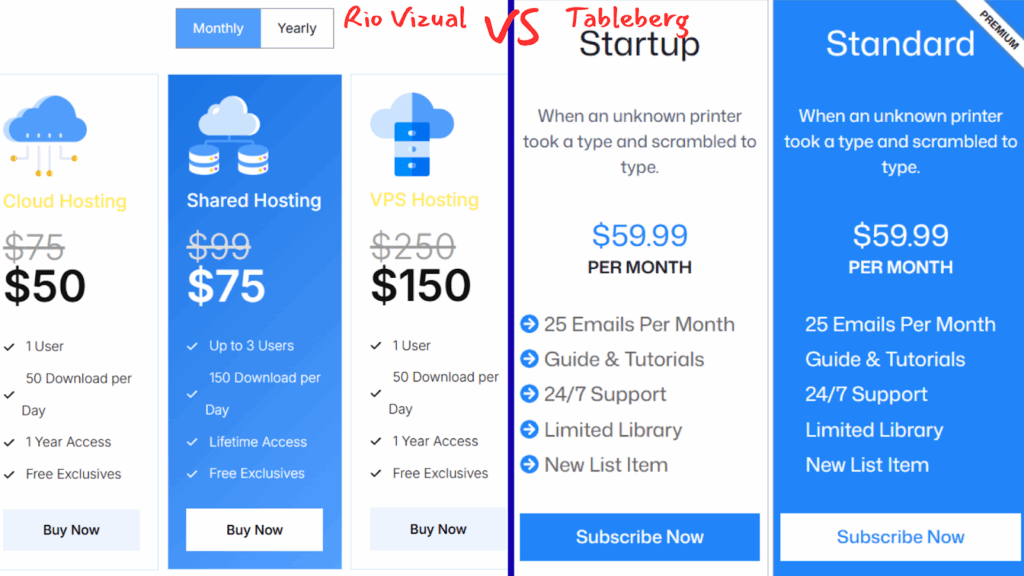
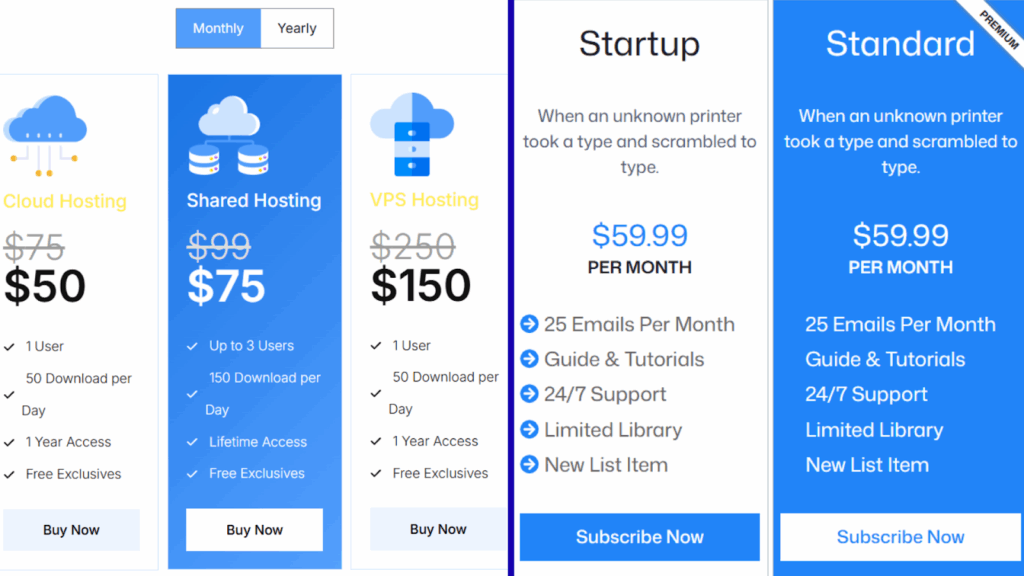
Ease of Use: Tableberg vs RioVizual
Now, move on to how user friendly these two plugins are. Though, both of the two plugins offer simple and easy interfaces, let’s take a closer look to see which one truly excels in terms of user experience.
In both plugins, the elements bar and customization options are located in similar areas. A “+” icon appears within each cell, allowing users to insert elements. Once an element is selected, a customization panel appears on the right side to tweak styles and settings without leaving the editor.
Still, there is a slight difference in element adjustment between the plugins.
In Rio Vizual, you will have a dedicated menu bar with each element to duplicate, copy, cut, delete and even move elements up and down. You can easily shift your elements from one cell to another with a hand cursor.

However, in Tbaleberg, you can also copy, cut, duplicate, elements, but with the WordPress default options. So, there will be other unnecessary options in the list and you have to enter a new block to paste the elements.
Again, there are no hand cursor or other handy options to move your elements from one cell to another.
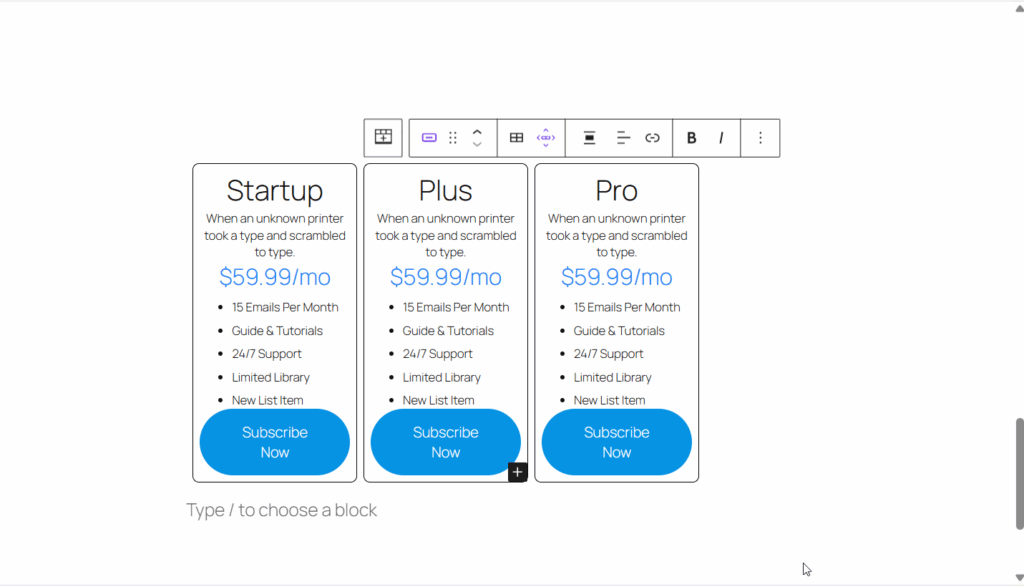
On another note, Rio Vizual offers multi cell selection with holding shift and bulk editing option, while there are no such features in tableberg. So, you’ve to manually select each cell and edit it individually.
So, while both plugins follow a block-based editing style, Rio Vizual tends to offer more flexible and quicker controls to more easily handle your table over table berg.
Table Elements Comparison: Tableberg vs RioVizual
For creating tables, both plugins offer certain elements you can add inside table cells to enhance content and visuals.
For table contents, Rio Vizual offers a total 14 elements for creating basic to advanced, interactive tables, while Tableberg includes 8 elements for clean, content-based layouts.
Let’s check out the available elements of Rio Vizual and tableberg in the table below:
| Element | Rio Vizual | Tableberg |
| Text / Paragraph | ✅ | ✅ |
| List | ✅ | ✅(Gutenberg default) |
| Styled List | ✅ | ✅ |
| Image | ✅ | ✅ |
| Button | ✅ | ✅ |
| Icon | ✅ | ✅ |
| Star Rating | ✅ | ✅ |
| Shortcode | ✅ | ❌ |
| Media & Text | ✅ | ❌ |
| Price | ✅ | ❌ |
| Title | ✅ | ❌ |
| Icon Button | ✅ | ❌ |
| Dual Button | ✅ | ❌ |
| Divider | ✅ | ❌ |
| Ribbon / Badge | ❌ (use badges) | ✅ |
| Custom HTML | ✅ | ✅ |
Note: While using Rio Vizual, you’ll get access to unique elements based on the table type you select. For example, in pricing tables, you’ll find dedicated elements like Price and Title, specifically designed for that use case. On the other hand, in the general Table Builder layout, elements like Dual Button, Advanced List, and Media & Text are available.
However, for tableberg, there is no such dedicated element list for specific tables.
Table Customization Comparison: Tableberg vs RioVizual
Well, for visually appealing table building, the plugin should include complete and advanced style customization from fonts, colors to backgrounds and spacing for each cell even elements.
RioVizual and Tableberg enable a right side table styling panel for rows, columns, cells, and elements as well.
In case of table styling options, Rio Vizual includes three dedicated tabs (General, Style, and Advanced) to manage layout, design, and advanced styling for every single element. Within the Style tab itself, there are two subtabs: Global and Custom, to apply site-wide styles or all labels of customization for a more refined look.
In contrast, Tableberg has no separate styling panel. Instead, its customization options are integrated into WordPress’s default block settings and styles tab.
However, let’s check the different custom table styling options of both plugins and find out which offers better.
| Table Styling Feature | Rio Vizual | Tableberg |
| Table Content Styling | Offers 8 content tags (div, paragraph, H1–H6) with built-in styling options | 4 predefined styles (default, display, subtitle, annotation) |
| Header & Footer Styling | Full control: set background, font, text color, size, and typography separately | Only allows background color change—no font or text style control |
| Image Styling | Control image size, add link, open in new tab, insert from media, device, or URL | Control size (with duotone), add link, insert from media/device only |
| Cell-Level Styling | Choose between collapse and separate cell styles; control padding, borders, shadows, spacing | No specific cell styles; only basic cell spacing and padding |
| List Styling | 6 list icon styles with color customization | 2 basic icons; no color change options |
| Typography Controls | Wide font selection with diverse weights and styles | Limited fonts with basic weight |
| Button Style Variants | 2 variations: Single & Dual buttons, with filled and outline styles | No style variations; can only adjust button width |
| Row/Column Background | Apply solid or gradient backgrounds to rows, columns, or individual cells | Supports solid and gradient backgrounds for even/odd rows, columns, and cells |
| HTML cell tag | Td & th | ❌ No |
| Hover Effect | ❌ No | Button hover effects |
| Sorting | ❌ No | vertical & horizontal sorting with data search |
Note: You can remove the specific styling anytime with both plugins, but Rio Vizual includes one overall reset button under the advanced tab to remove all styles in just one click.
So, if you need advanced design flexibility, Rio Vizual wins hands down with deeper styling options, more control over each element. Tableberg is simpler and quicker for basic tables, but lacks fine-tuned design controls.
Responsiveness: Tableberg vs RioVizual
Both plugins aim to create tables that look good across devices, but they approach responsiveness differently, especially when it comes to mobile behavior.
Rio Vizual offers dedicated toggle options to automatically make your table responsive across all devices based on screen size. Again, with tableberg, you can adjust the width of your table for desktop, tablet and phones to make it responsive.
Let’s compare the responsive settings for Rio Vizual and Tableberg below:
| Responsive Feature | Rio Vizual | Tableberg |
| Auto Scrollbar on Large Devices | ✅ Yes | ❌ No |
| Auto Scrollbar on Small Devices | ✅ Yes | ❌ No |
| Responsive Breakpoint Control | ✅ Yes | ✅ Yes |
| Responsive Mode | ✅ Stack & scroll | ✅ Stack & scroll |
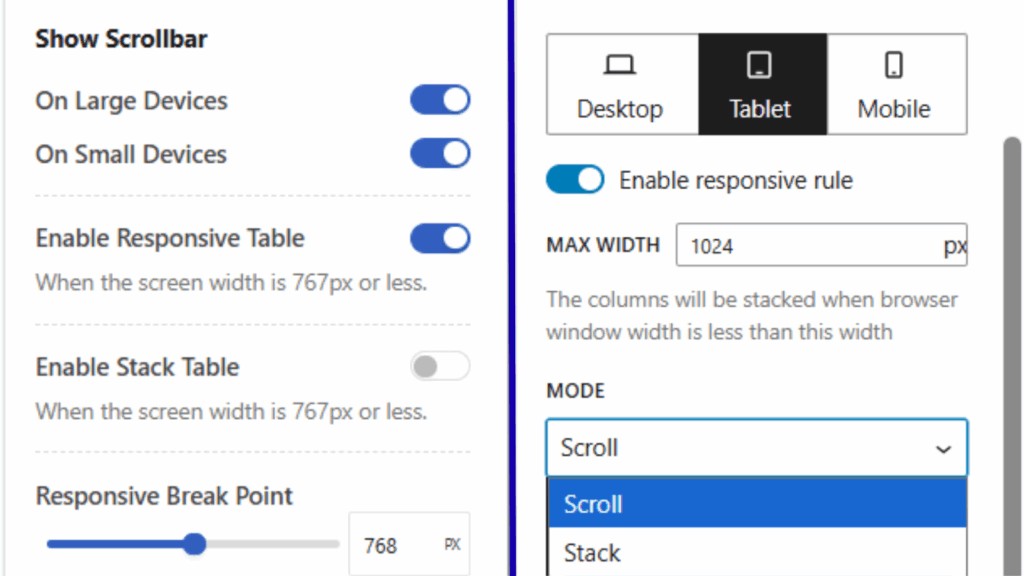

Free Features: Tableberg vs RioVizual
Well, so far, I’ve covered the key comparison areas that matter when choosing between these two plugins. Both Rio Vizual and Tableberg offer a mix of similar and unique features to help your tables stand out.
However, since both plugins follow a freemium model, it’s also important to compare how many and what features are available in their free versions. This helps you decide whether the free version meets your needs or if upgrading to the pro version is actually worth it.
So, let’s compare the free versions of Rio Vizual and Tableberg:
| Feature | Rio Vizual (Free) | Tableberg (Free) |
| Pre-built Templates | 52 free templates out of 67 | 6 free templates out of 29 |
| Free templates for specific Table Types | Comparison & other: 27 out of 29 Pricing: 19 out of 25 Pros & cons: 6 out of 13 | Pricing: 2 out of 8Pros & cons: 1 out of 4Others: 2 out of 5Comparison: 0 out of 8Feature box: 1 out of 4 |
| Styling Elements | 6 free out of 12 (text, image, button, icon, list, shortcode) | 4 free out of 9 (text, image, button, list) |
| Header/Footer Styling | Yes | Background color only |
| Cell-Level Styling | Yes | Just padding and spacing, no border |
| Responsiveness | Stack, scroll table with sticky row/col | Stack, scroll table; no sticky row/col |
| Typography Control | All fonts and weights available in free | Very limited (3 fonts, basic weight) |
So, with the free version of Rio Vizual, you can create not just basic but even some moderately advanced tables with styling flexibility and layout control. However, for tableberg, with the free version, only the basic tables are possible.
Table previews: Tableberg vs RioVizual
Well, now that we’ve compared all the key features, it’s time to put them to the test. Let’s create tables using both Rio Vizual and Tableberg and see firsthand which one feels more advanced, flexible, and feature-rich in real-world use.
Rio Vizual Table Demo:

Tableberg Table Demo:

Pricing & Plans: Tableberg vs RioVizual
Now, it’s time to compare the pricing plans for rio Vizual and Tableberg. Here’s a breakdown of all the current pro plans for each:
| Rio Vizual Pro | Tableberg Pro |
| Personal: $49/year For 1 site and 1 year updates | Individual: $50/yearFor 1 site and 1 year updates |
| Professional: $99/year For 10 site and 1 year updates | Agencies: $70/yearFor unlimited sites and 1 year updates |
| Agency: $149/year For unlimited site and 1 year updates | Lifetime: $256For unlimited sites and lifetime updates |
| ✅ 30-day refund policy | ✅ 30-day refund policy |
Final Verdict: Which Table Plugin Is Right for You?
While both Rio Vizual and Tableberg are Gutenberg-based plugins, their features are tailored for different use cases. After reviewing and testing both plugins hands-on, here’s my final recommendation:
If you need a plugin for creating professional level custom tables with modern design elements, pre-built templates, advanced styling options, Rio Vizual is the best pick.
However, if you’re looking for a lightweight, no-frills table builder with basic customization and simplicity, Tableberg will be a good choice.
In Short:
- Choose Rio Vizual if you want:
- Advanced design & styling
- Premium table elements
- Large set of Pre-designed templates
- Choose Tableberg if you want:
- Basic custom features
- Table outside layout like feature box
Though both plugins currently have just over 1,000+ active installations, they’ve rapidly gained popularity for their unique use cases. And since both Rio Vizual and Tableberg offer freemium plans, you can easily try out the free versions to see which one fits your needs before deciding to invest in the Pro version.
FAQs about Tableberg vs RioVizual
- Are both Rio Vizual and Tableberg compatible with the Gutenberg editor?
Yes, both plugins are built specifically for the Gutenberg block editor and work seamlessly inside it without requiring any shortcodes or external interfaces.
- Which plugin has more advanced table templates?
Rio Vizual offers more advanced and customizable templates even most in the free version, while Tableberg provides simpler, basic templates.


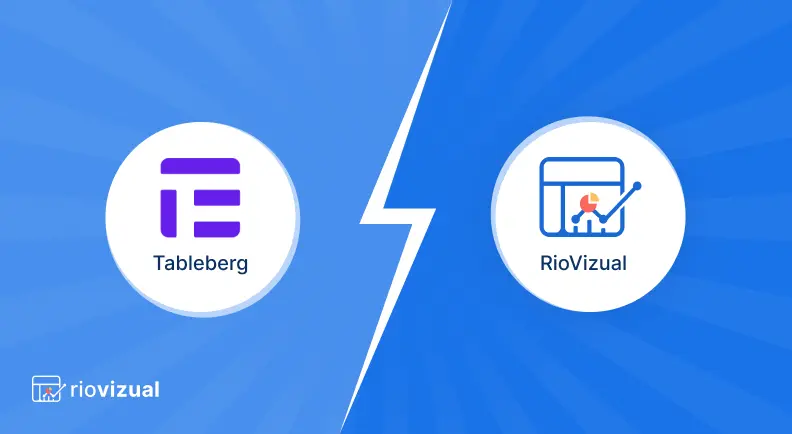

Leave a comment